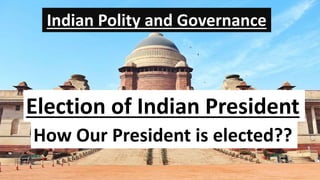
Lecture 11 election of the president
- 1. Indian Polity and Governance Election of Indian President How Our President is elected??
- 2. Lecture 11 By Vishnu Agarwal Election of Indian President
- 3. Subscribe Channel Like Facebook page “The Learning India” with ID @TLI.vishnu
- 4. Article 54 - Election of President “The President shall be elected by the members of an electoral college consisting of— (a) the elected members of both Houses of Parliament; and (b) the elected members of the Legislative Assemblies of the States. (c) State includes the National Capital Territory of Delhi and Puducherry. (Thus, elected members of these union territories shall also participate in elections.)”
- 5. •Thus, following cannot participate: Citizens. Nominated members of Lok Sabha and Rajya Sabha. Nominated members of State legislative assemblies. All members of state legislative councils. Nominated members of Delhi and Puducherry assemblies.
- 6. •Why no Direct election for President: President is not real executive. Direct election has huge cost on exchequer. If both President and PM are directly elected, then chances of conflict increases. •MPs and MLAs can vote in President’s election by virtue of their membership to house. Thus, if any member loses his membership of the house or house is dissolved, they cannot vote.
- 7. Article 62 - Time of holding election to fill vacancy in the office of President and the term of office of person elected to fill casual vacancy •If vacancy is due to expiration of the term of office - Elections shall be completed before the expiration of the term. •If vacancy occurs due to his death, resignation or removal, or otherwise - Election shall be held in no case later than six months from, the date of occurrence of the vacancy. •The person elected to fill the vacancy shall be entitled to hold office for the full term of five years from the date on which he enters upon his office.
- 8. Article 55 - Manner of election of President •The Objective is to secure uniformity: •Among the States. •Between the States as a whole and the Union. •Accordingly, the number of votes which each MP and MLA is entitled to cast shall be determined in the following manner:—
- 9. (a) Quantity of votes held by each MLA: Value of the vote of an MLA = Total population of state 1000 * Total number of elected MLAs Suppose, total population of a state is 10 lakh and MLAs are 100. Then, each MLA will get 10 votes. (b) If there is a remainder in above case, then it will be settled as follows: If remainder is more than 0.5, then 1 is added. For example, votes of MLA arrive at 256.555 – then it will be counted as 257. If remainder is less than 0.5, then it will be neglected.
- 10. (c) Quantity of votes held by each MP: Value of vote of an MP = Total “value of votes” of all MLAs Total number of elected MPs Suppose in MLAs example (if there is only one state), total value of votes of all MLAs is 100*10 = 1000. If number of MPs is 10, then each MP will get 100 votes. (d) Rules for remainder is same as we saw in case of MLAs. (e) ‘Population’ means until the relevant figures for the first census taken after the year 2026 have been published, be construed as a reference to the 1971 census.
- 11. •The election of the President shall be held in accordance with the system of proportional representation by means of the single transferable vote and the voting at such election shall be by secret ballot. • Each voter (MP and MLA), while casting his vote, is required to indicate his preferences by marking 1,2,3 and so on against the name of candidates. • Initially, first preference votes are counted. If any candidate secures required quota, he is declared elected. • If this does not happen, then, first preference votes of last candidate are cancelled and his 2nd preference votes are transferred as they are 1st preference. This process continues till a candidate secures the required quota. • Successful candidate has to get one vote more than 50% of total votes given. This will ensure absolute majority to one candidate.
- 12. 14th Presidential Elections Nominee Ram Nath Kovind Meira Kumar Electoral vote 7,02,044 3,67,314 Percentage 65.65% 34.35% •As of 2017, the electoral college comprises 776 MPs and 4,120 MLAs. •Total eligible votes were 10,98,903 votes, yielding a threshold for a majority of 5,49,452 votes.
- 13. Shortcomings •No participation to distinguished Nominated personalities of Rajya Sabha and Nominated anglo- Indians of Lok Sabha. •No participation to citizens – party politics can’t be checked. •No single transferable votes. •Secret Ballot – Internal whip by parties, if any members votes against wishes of Party leadership.
- 14. Article 71 - Matters relating to, or connected with, the election of a President or Vice-President •All doubts and disputes arising out of or in connection with the election of a President or Vice-President shall be decided by the Supreme Court whose decision shall be final. •If the election of a person as President or Vice-President is declared void by the Supreme Court, then acts done by him, on or before the date of the decision of the Supreme Court, shall not be invalidated by reason of that declaration.
- 15. •Parliament may by law regulate any matter relating to or connected with the election of a President or Vice-President. •The election of a person as President or Vice- President shall not be called in question on the ground of the existence of any vacancy among the members of the electoral college electing him.
- 16. Thank You